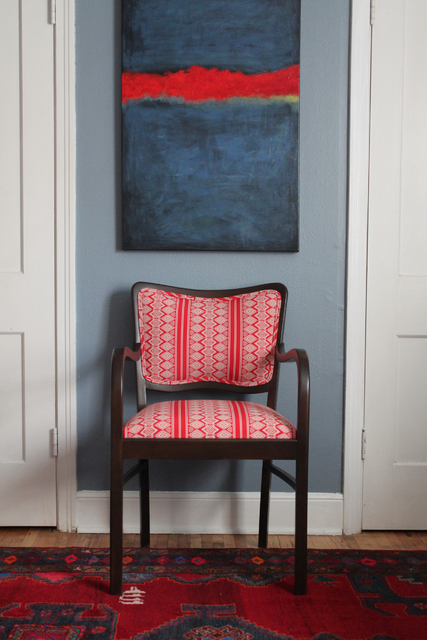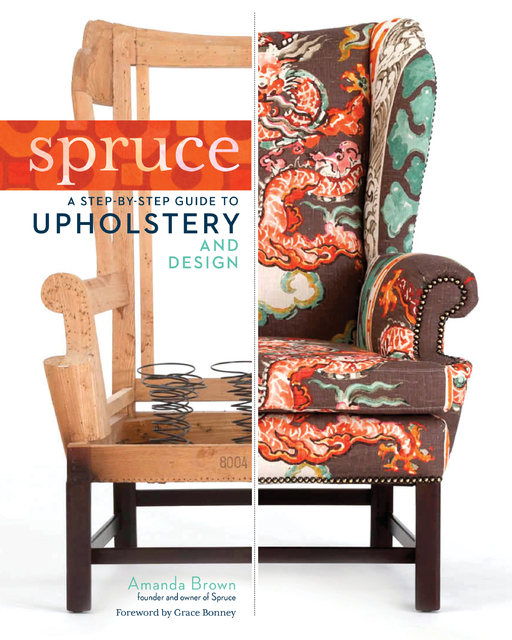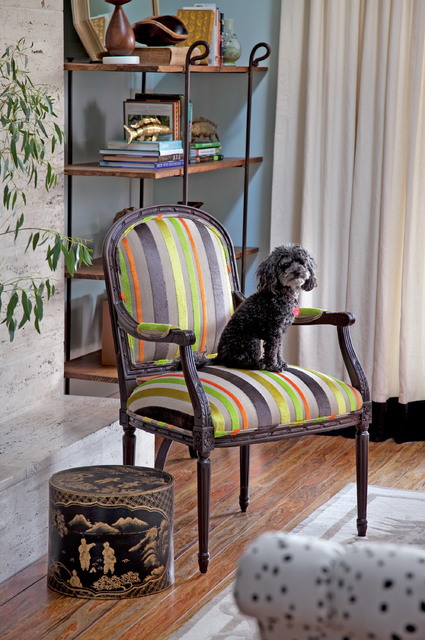Amanda Brown encourages creative types who are looking to upgrade their furniture to think outside the box — big-box retailers, that is. ADVERTISING Amanda Brown encourages creative types who are looking to upgrade their furniture to think outside the box
Amanda Brown encourages creative types who are looking to upgrade their furniture to think outside the box — big-box retailers, that is.
“I’m not the same person as 1,000 other people with the same sofa, so why should my furniture be?” asks the furniture upholsterer and owner of Spruce, an Austin, Texas, furniture-redesign studio.
She sees potential in outdated, neglected furniture. But before reupholstering a family heirloom, she says, learn the basics of the craft with an inexpensive thrift-store find. A smaller, less time-intensive piece such as an armchair is a great place to begin.
“Most people start with something they have — a sofa or something — and that’s a good way to get overwhelmed,” Brown warned. She describes how to refinish a Louis XVI chair among other projects in her book, “Spruce: A Step-by-step Gide to Upholstery and Design” (Storey, 2013).
Eddie Ross, East Coast editor and producer of home design for Better Homes and Gardens magazine, recommends that novices start even simpler: Make a window cornice or reupholster a small seat back, using only a staple gun, foam batting and fabric.
“You don’t want to waste all that time, fabric and materials,” said Ross. “You want to be happy at the end of a project.”
Better Homes has an online reupholstery project, “How to Reupholster a Chair,” that offers quick results at www.bhg.com/decorating/do-it-yourself/fabric-paper-projects/diy-chair-upholstery-guide.
What furniture is worth a redo? Usually, it’s any new or old piece made with wood rather than particleboard or melamine.
Brown suggests picking up the end of a chair or sofa to gauge its weight. Hefty is good. Check the armrests and legs: Are they sturdy or do they wiggle? Woodworking repairs can be costly and difficult.
Brown also suggests hunting for the dirtiest, ugliest furniture at garage sales and flea markets.
“If the piece looks dirty or the padding is sunken in, those are the things people stay away from and those are the things I look for. I want it as ugly as possible so I get the best price,” said Brown, adding, “it just makes for a much more satisfying ‘before’ and ‘after.’”
Start the upholstery process with deconstruction, carefully removing fabric, underside dust cover and all parts — batting or foam padding, welting and tack strips — down to the wooden frame. Take copious pictures of each step to make reassembly easier, and try not to tear the fabric, dust cover or welting (the fabric-covered cords that cover staples, tacks and seams, and lend furniture a finished look); these are your patterns.
Stripping furniture “doesn’t require any skill,” said Brown. “It just requires some brute strength and some hand tools. And it’s so educational when you’re doing it. You really start to ‘get it’ when you take something apart.”
“It’s almost like an operation,” said Ross.
A few necessary tools: Gloves (to prevent blisters), protective goggles (in case of errant staples or tacks), pliers, staple remover, staple gun and scissors.
Brown also uses a pair of sawhorses and clamps to keep her work at waist level during this time-intensive work, protecting her back.
“Blisters and backaches and frustration can equal abandonment of a project,” she warned.
Her favorite part is textile selection and searching for out-of-the-ordinary fabrics. She’s upholstered furniture with curtain panels, tablecloths and embroidery. She upholstered a dining-room chair with her mother’s crewel artwork. She’s currently reupholstering two chairs with old quilts.
“Using a special textile makes it so much more exciting,” she said.
You also can learn more about the upholstery process from YouTube videos and online tutorials. Or learn hands-on, as Brown did, in a technical or community college classroom.
“Really it’s just so exciting to take something that looks bad and make it beautiful again,” she said. “You just have to get to the end. And once you do, you get the bug, and you want to do more.”
For beginners, it’s also important to know when to call the professionals for help, said Ross. “A larger piece of furniture takes time and it’s definitely not a weekend project,” he warns. “… What you don’t see on the TV shows are the five people helping out on the project behind the scenes.”
Online:
www.spruceaustin.com






